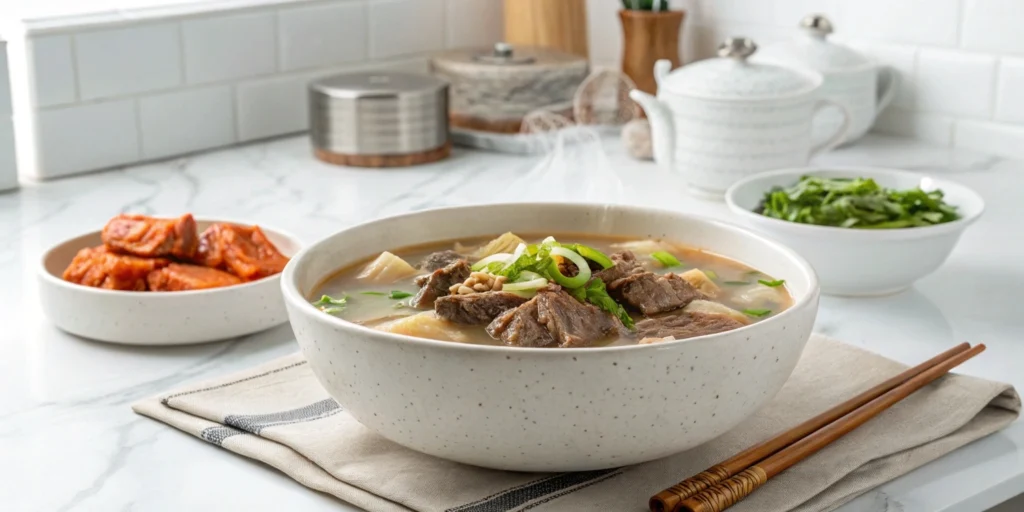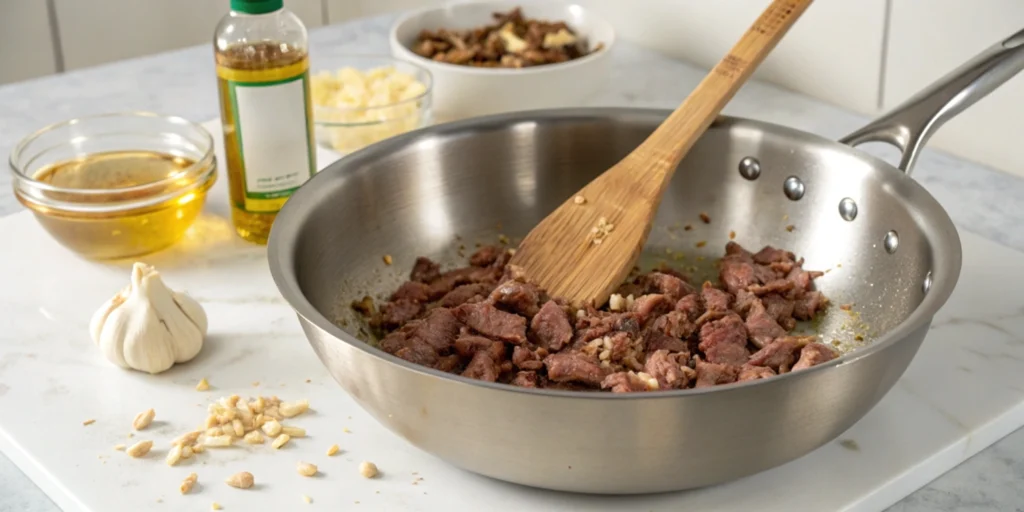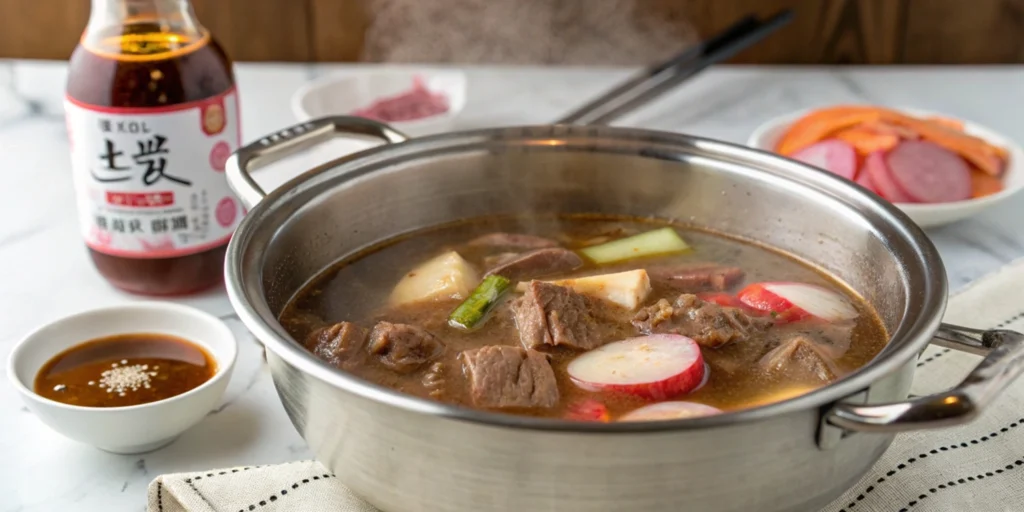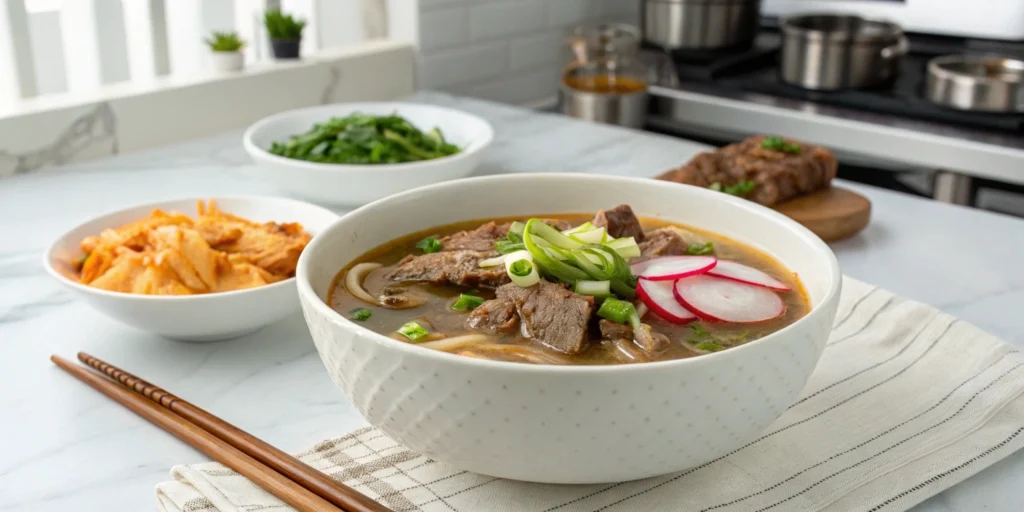
Table of Contents
In the heart of Korean cuisine lies a dish that embodies comfort, tradition, and nourishment: Korean beef soup. Known as soegogi-guk (소고기국), this warm, hearty bowl of goodness is a staple in Korean households. Its appeal lies in its simplicity and the depth of flavor it delivers, often transforming humble ingredients into a dish that feels like a warm hug. Whether you’re new to Korean cooking or a seasoned food enthusiast, this recipe will guide you through crafting a sensational version of Korean beef soup in just 30 minutes.
Why Korean Beef Soup Deserves a Spot on Your Table
Korean beef soup is more than a meal—it’s an experience. Every bite tells a story of family gatherings, cold evenings, and the art of creating something truly special from basic pantry staples. Here’s what makes this dish stand out:
- Flavorful and Nourishing: Tender beef cooked in a savory broth, complemented by the sweetness of Korean radish.
- Healthful Ingredients: A protein-packed, low-fat meal that’s rich in vitamins and minerals.
- Perfect for Busy Days: With minimal preparation, you can enjoy a steaming bowl of comfort without spending hours in the kitchen.
Ingredients for Korean Beef Soup

Before you begin, gather the following ingredients:
- 1 lb of beef brisket or shank, thinly sliced for tenderness
- 1 cup of Korean radish, peeled and cut into medium-sized chunks
- 4 garlic cloves, finely minced
- 2 tablespoons of soy sauce to enhance the savory taste
- 1 tablespoon of sesame oil to enhance aroma
- 8 cups of water or beef stock as the base of the soup
- 2 stalks of green onions, finely sliced for garnish
- Salt to taste
Optional additions:
- A teaspoon of gochugaru (Korean red pepper flakes) for a hint of spice
- Glass noodles for added texture
- Spinach or mushrooms for extra nutrition
How to Make Sensational Korean Beef Soup
1. Prepare the Beef

Begin by boiling the thinly sliced beef brisket in water for about 10 minutes. This process helps remove impurities while retaining the beef’s natural flavor. Drain the water and rinse the beef slices under cold running water. Set the beef aside.
2. Sauté for Flavor

In a large pot, heat one tablespoon of sesame oil over medium heat. Once the oil is shimmering, add the minced garlic and stir until fragrant—this is your flavor base. Toss in the beef slices and sauté them for about 2-3 minutes, allowing the meat to soak up the garlic’s aroma.
3. Build the Broth

Add the Korean radish chunks to the pot, followed by 8 cups of water or beef stock. The radish not only adds sweetness but also contributes to the soup’s light and clean finish. Increase the heat to bring the mixture to a rolling boil, then reduce it to a simmer. Allow the soup to cook for 20 minutes.
4. Season the Soup
Stir in two tablespoons of soy sauce and a pinch of salt to taste. If you prefer a bit of heat, add gochugaru to the broth. Let the soup simmer for another 5 minutes, allowing the flavors to meld beautifully.
5. Serve with Style
Ladle the soup into serving bowls, making sure each bowl has a generous portion of beef and radish. Top with finely sliced green onions for a pop of color and fresh flavor. For a complete Korean meal, serve with a side of steamed rice and a small plate of kimchi.
Tips for Perfect Korean Beef Soup
To ensure your soup turns out just right, keep these tips in mind:
- Choose the Right Beef: Cuts like brisket or shank work best due to their rich flavor and tender texture.
- Don’t Skip the Radish: Korean radish is essential for the authentic taste and balances the dish with its subtle sweetness.
- Experiment with Additions: Glass noodles, spinach, or mushrooms can elevate your soup, adding more texture and nutrients.
- Taste as You Go: Adjust the seasoning to your liking—everyone’s palate is unique!
Nutritional Benefits of Korean Beef Soup
Korean beef soup isn’t just delicious; it’s also packed with health benefits:
- High in Protein: The beef provides essential amino acids that support muscle repair and overall health.
- Low in Fat: Despite its hearty taste, this soup is a light meal option.
- Rich in Vitamins: Korean radish is a powerhouse of Vitamin C, fiber, and antioxidants, promoting digestive health.
- Hydrating and Restorative: The broth keeps you hydrated while replenishing your body with nutrients.
For those focusing on health-conscious eating, this dish is a wonderful balance of indulgence and nourishment.
The Cultural Essence of Soegogi-guk
Korean beef soup is a reflection of Korean culture—rooted in resourcefulness and the celebration of simple ingredients. It’s often served during cold months, providing warmth and comfort to families. The dish also symbolizes care and hospitality, frequently shared during gatherings or as a gesture of kindness to guests.
Its versatility is another reason for its popularity. Whether served as a main dish or as part of a larger spread, soegogi-guk is adaptable, catering to diverse palates and dietary preferences.
Frequently Asked Questions About Korean Beef Soup
Q: Is Korean beef soup traditionally spicy?
A: No, it’s typically mild. However, you can add gochugaru or chili oil to customize the spice level to your liking.
Q: Can I make Korean beef soup ahead of time?
A: Yes! You can refrigerate this soup for up to 3 days while retaining its delicious flavor. Reheat on the stove for the best flavor and texture.
Q: What can I pair with Korean beef soup?
A: Serve it with steamed rice, kimchi, or banchan (Korean side dishes) for a complete meal.
Q: Is it possible to substitute with another type of beef cut?
A: While brisket and shank are preferred, you can use any tender cut of beef, such as sirloin or chuck.
Q: Is Korean beef soup suitable for vegetarians?
A: You can create a vegetarian version by replacing beef with tofu and using vegetable stock instead of beef stock.
Conclusion: Bring Korean Comfort to Your Kitchen
Creating a bowl of Korean beef soup is more than just cooking—it’s an exploration of flavor, tradition, and care. In just 30 minutes, you can bring this classic dish to life in your own kitchen, impressing your loved ones with its heartwarming taste and nutritional value.

Whether you’re looking to expand your culinary skills or simply craving something soothing, soegogi-guk is a recipe that won’t disappoint. So, grab your apron and get started—it’s time to experience the sensational taste of Korean comfort food!
If you enjoyed learning about Korean beef soup, share this recipe with your friends or bookmark it for your next family dinner. Let us know how your version turned out in the comments!
